
- Source: Cultured Magazine
- Author: Renée Green and Kandis Williams
- Date: October 19, 2021
- Format: Digital
Renée Green and Kandis Williams
Share an Artistic Frequency
Renée Green and Kandis Williams have never met IRL, but they share a frequency as artists invested in language, publishing and their collusions with the visual. Both educators, editors and filmmakers, Green and Williams have carved pathways through art’s traditional categories to create new spaces to explore. This has included founding publishing houses (Williams runs Cassandra Press) and dream production companies (Green’s Free Agent Media is more than a decade old). As a reward for this pioneering, they’ve been repeatedly told by institutions that there is no lineage for their ideas and work, when in fact it’s quite clear it is only a Zoom call away. Here, we ask Green and Williams—ahead of major shows at the KW Institute and Ebony L. Haynes’s new Tribeca gallery, 52 Walker, respectively—to break the ice and begin unpacking the potential of what this intergenerational dialogue could look like.
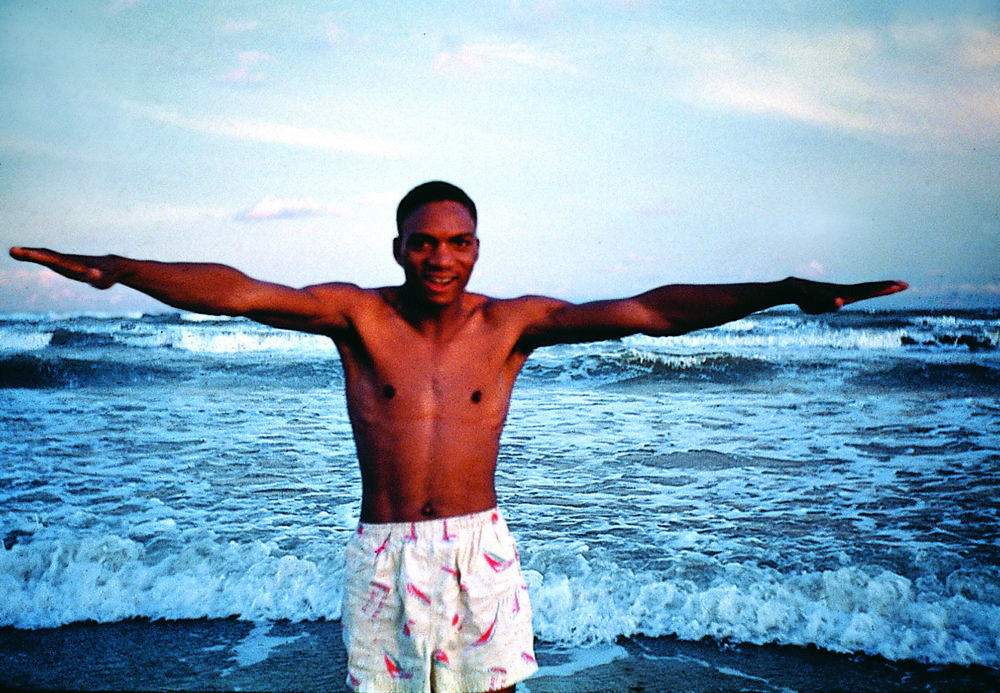
A film still from Renée Green’s Partially Buried Continued (1997).
Courtesy of the artist, Free Agent Media and Video Data Bank, Chicago.
Kandis Williams: I feel like you’re one of the artists that I discovered after going to Cooper. I spent half my time at Cooper at the Beaux-Arts in Paris, and I didn’t find out about your work until the end.
Renée Green: What year was that?
KW: 2006.
RG: I had a film retrospective at the Jeu de Paume in 2008.
KW: Yes, exactly. That’s where I first got familiar with your work. I was leaving France when that exhibition opened. I have private beef with the whole art world for your work not feeling centered.
RG: Thank you!
KW: It was really nice to get your dossier for this interview because it’s like cutting teeth trying to find your catalogues.
RG: That’s crazy, because there’s so many of them.
KW: I know.
RG: It doesn’t make sense, but this relates to publishing, the way things circulate between countries and between languages, as well as how certain institutions distribute work.
One of the main gaps you might have encountered is that I was not in the United States for about 12 years. I was always back and forth, but most of my production was abroad, so that created a schism in terms of visibility. I wasn’t necessarily thinking about connecting or being present all the time. I’m always out of sync, which I don’t actually mind. I was focused on doing my projects and on what I was interested in. I was doing different forms of investigation and research, thinking and producing work. In 2003, I returned to the US and I lived in California, which is not New York, for eight and a half years. I was going to LA, but I wasn’t trying to be part of anything.
KW: It’s funny, with the last couple years, especially with the pandemic, I feel like it’s really interesting how fractured, how in sync and out of sync the work that we do is. I’ve been thinking about how much in front of time they are, and I don’t want to say they’re “ahead” or “avant-garde,” because I know those phrases have connotations that are very much behind innovation. They’re like capturing mechanisms, but I’ve just been crunching and thinking about that in terms of how do we site ourselves in that cycle? How can we attune without syncing? I’m so grateful for how out of sync I’ve been. It saved my life a little bit. You know what I mean? It saved my practice for sure.
RG: I agree with that. That’s why I say it doesn’t bother me at all being out of sync. I’ve also been examining a different kind of pacing. For example, focusing on where I am and what I want to do there, that is my focus, so that can take me to all kinds of times and places.
During this time of stillness and not too much travel, it’s been possible to reflect on these things while still working. I’m focusing now on a survey exhibition, and I know that this kind of exhibition can seem to clash with what I want to perceive in the present, yet it too is facing now. The exhibition is called “Inevitable Distances.” This process has allowed me to think about an asynchronous way of being and perceiving. Even if there are moments of asynchronicity that can be very resonant, there are still distances. There are differences and distances between all of us.
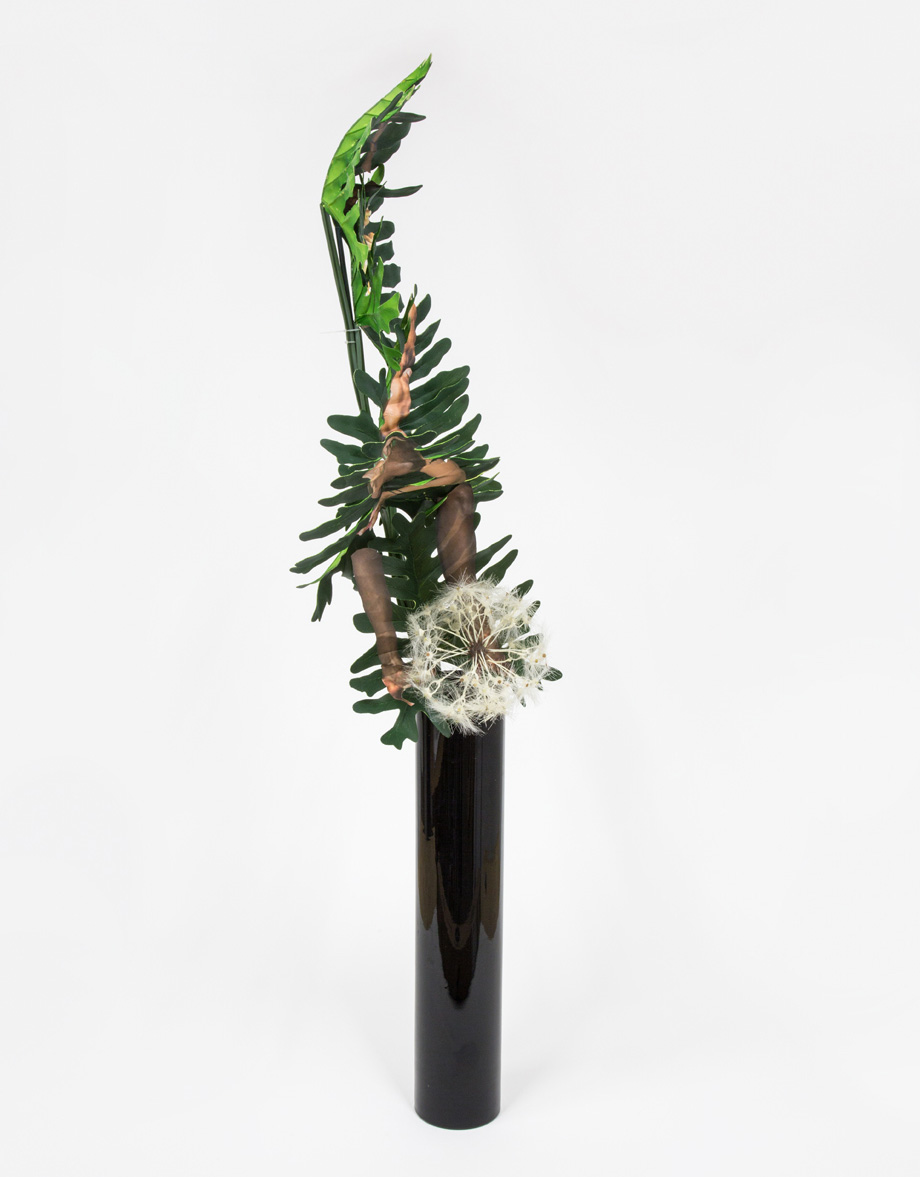
Kandis Williams's Semba Kizomba Candombe Cayenge, Coroba: dance notation on cascading selloum philodendron arrangement (2020).
Courtesy of Night Gallery and David Zwirner.
KW: Silences as well—I feel like distances and silences. When you say “distance,” I immediately think of “dissonance.” A friend of mine, Leilah Weinraub, made a documentary about central LA lesbian clubs called Shakedown (2018), and she was talking to Mireille Miller-Young, who wrote A Taste for Brown Sugar (2004). She was editing it for like 10 years and one of Miller-Young’s questions was, “Why now?” Leilah replied, “After 10 years of gathering all this footage, it was like the world wasn’t a place where I could speak about what I had done over the last 10 years until now.”
RG: Yes, that happens. Researching your work for this conversation, I was really struck by a lot of things that you have actually said and have been referencing, because they resonate with a number of my works that you would not have seen. I would say almost all the topics that you touched on, particularly botany and gardens.
KW: I think about “Fear, Flight and Fate” from Sites of Genealogy (1990) all the time. I think I’ve only seen those couple of magazine images from it.
RG: That work has only been presented once, and it’s going to be reconfigured in the Berlin exhibition, which is going to be a very unusual survey. It’s still unfolding as we speak, with a number of participants who I hadn’t met before. I knew the person who invited me, Mason Leaver-Yap, and they wanted me to be in conversation with some younger people from different places who they thought could be interesting to be in touch with about the work.
Most of them have only seen the work in reproductions. They have not ever physically encountered it, and so much of these works have to do with a visceral encounter, as well as space and sound. Sites of Genealogy, the piece that you mentioned, is going to be in Berlin at KW [Institute for Contemporary Art], and I’m rethinking how that can happen because it was sort of a solitary performance during a year, in the peripheral spaces of PS1, before it was gutted and renovated to become MoMA. I used the cellars, the stairway and the attic.
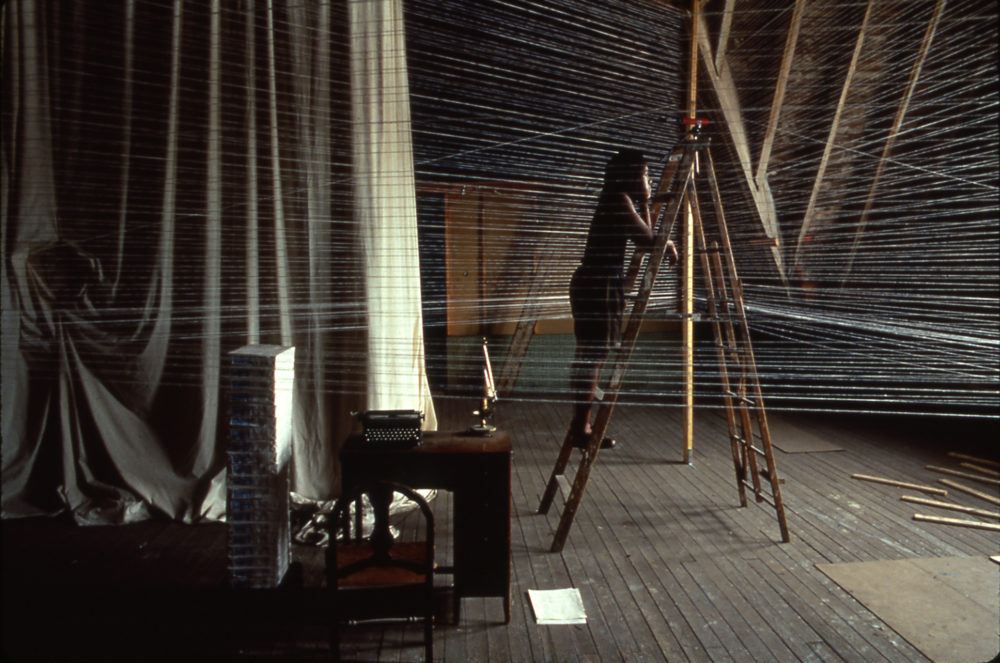
Renée Green’s Sites of Genealogy (1990). Courtesy of the artist and Free Agent Media. Photography by Tom Warren.
KW: It’s interesting because I feel like I’ve lived in Germany for a while too, for 12 years as well.
RG: That’s a long time. Are you still living there, or are you back and forth? What are you doing?
KW: I don’t know right now. I feel like I gave a lot of time away in 2020, and I’m really fighting to find time again. I’ll do whatever gives me time.
RG: I’m there too, yes.
KW: I’m waiting for a necessity to show its face and for innovation, or some idea, to follow. Right now, I’m thinking so much about theater and this weird operative semiotic space that is like caricature and is the mimetic demands that caricature places on how we behave in public basically. It’s the Shakespeare thing, I guess, the theater of the world. He’s a white writer from the sixties, but Peter Brook, who wrote The Empty Space (1968)—do you know this text?
RG: I don’t know that text, but I’m familiar with Peter Brook.
KW: He calls it the deadly theater. There is the rough theater, the holy theater, the immediate theater and the deadly theater. I don’t really agree with all those distinctions, but I feel like there’s almost mediocre boundaries or something in between. It is like the means of production are the only differentiating force. How have you made moving in between so many hybrid forms of production, especially going from a book to a room to a concept, feel so natural?
That’s why I really feel like I resonate with your practice. It actually makes me angry that I haven’t seen more of your work because I feel like I was denied language where I’ve had individual conversations about how my work might fit into art history. I’ve been told, “We don’t know where it fits, there is no place for it. It’s too much. It’s too dense. It’s too da, da, da, like you’re not an expert at, you’re not a professional of, you’re not an expert at…”
RG: Where to begin with that? I am looking at formations, like university for example. What you describe is the response I got too, when I wrote my thesis in 1981, Discourse on Afro-American Art. It focused on the discourses being developed in the 1920s and 1960s, but through the documents, what was possible to find written by writers of African descent as well as of European descent. Looking at those two time periods and the relays between those decades, there was a possibility that people who lived during the 1920s would still be alive in the 1960s, which was the case with W. E. B. Du Bois.
I remember when I was trying to find an advisor in art history. I was an art student, but I was trying to cross into other disciplines. That was the moment people tried to cross over, trying to mix things together, and the whole notion of the interdisciplinary was something that you were encouraged to do, yet there was no infrastructure, there were no means to actually do it effectively. And then, everybody seemed to be afraid of it. I actually don’t think it’s ever been resolved. I was actually pushed to a music professor of African descent to be my advisor. The art history professor said he did not feel competent to weigh in on those writings, even though they were all about art. I was saying, “Well, the sources are from the art cultural realm.” And there was a third advisor, someone else who was in Asian Studies, a sinophile. Those are the people that I ended up having on my thesis committee; but it was a stretch to get anyone to engage, beyond my thesis advisor.
KW: Yes, it feels to me like especially in the last two or maybe four years, following the last fascist tide or something, Blackness seems to serve a very different architectural program than before. There’s a lot of mandates to perform and to participate in Blackness. The constructs are almost split. I’m realizing so much structural violence is embedded in literary fiction and in narrative devices. The image propels so much violence, and then we’re asking violent images to stop being violent.
RG: I’ve been finding it extremely perplexing, the past four years in particular. There seems to have been an erasure of the questioning that had arisen 20, 30 years before, questions about the image, about representation, even Laura Mulvey’s analysis about the position of women in front of the camera. Things that I was very conscious of in the late eighties, when I was trying to make work that could address some of these questions.
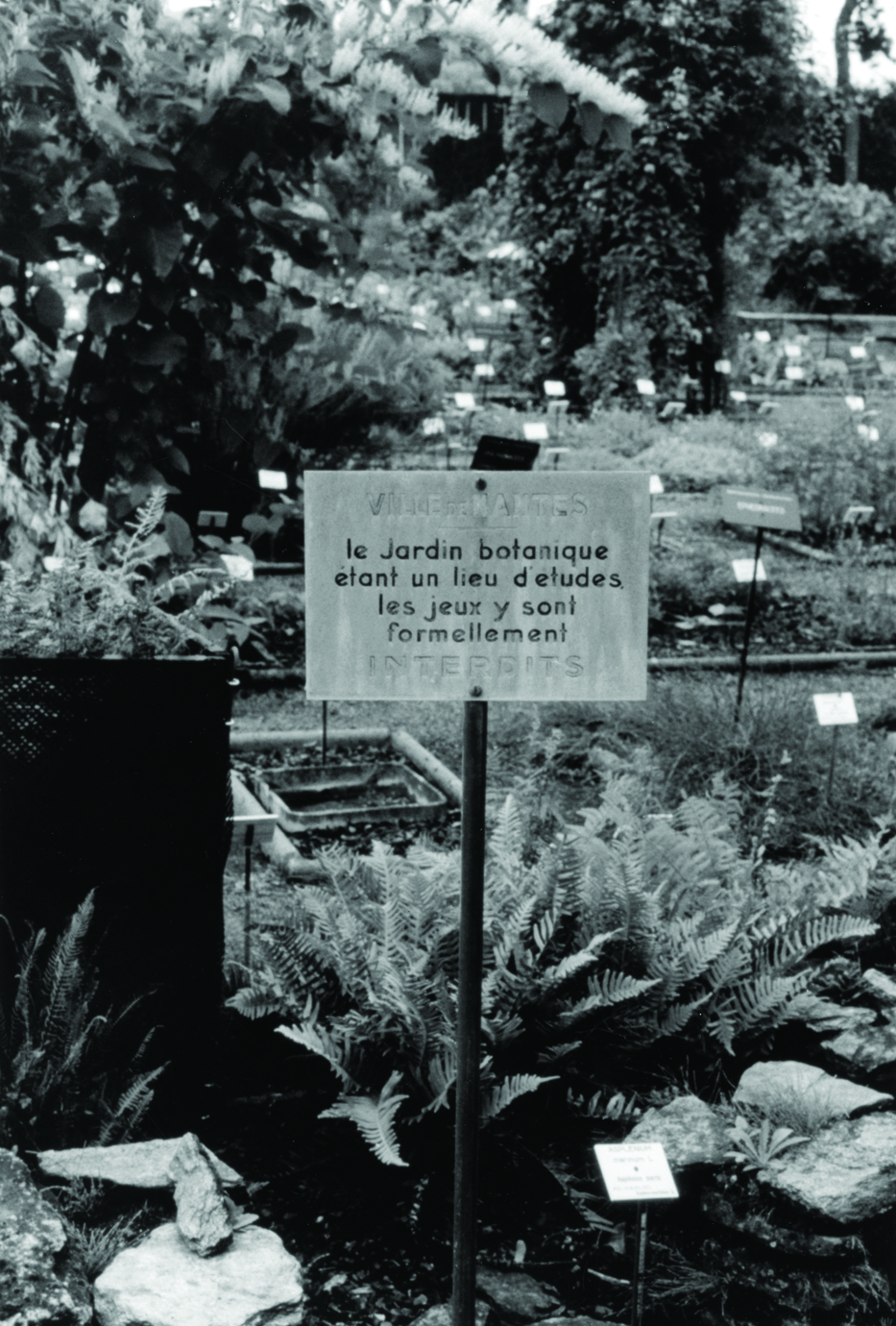
Renée Green’s documentation of Mise-en-Scène: Commemorative Toile (1992-94).
Courtesy of the artist, Free Agent Media and Bortolami Gallery, New York.
KW: There’s a book by Carrie Lambert-Beatty called Being Watched (2008), and it’s about Yvonne Rainer and the 1960s.
RG: I’m familiar with the book. I know Carrie, Yvonne is a friend.
KW: Oh, wow, great. Well [Yvonne] talks about mass media and the quote is like: “The problems that might have always been a part of experiencing art, but which at times in particular places become newly problematic and less productive for artistic work,” and she calls those “seeing difficulties.” I feel there’s an interesting thing, seeing that idea, but through Simone Browne’s surveillance culture, and just understanding that mass media has always been positioned as surveillance or it comes out of surveillance technology of the slave population.
RG: These are things that I have continued to be interested in, but bringing them together with some of the theoretical observations about representation, because that’s where I see a schism and that’s something that I aim to address. It’s very interesting, thinking about the choices of what to begin with, to think about, what it is that stimulates one, or what resonates for one. The reasons as to how one gets to something, rather than reacting to whatever is being projected onto you. In the present moment, there’s a lot that’s projected onto people. I would say it’s pretty violent and suffocating. I’ve been really interested in creating another way, another kind of space for existing, because this current moment is very silencing. And it seems like a contradiction, because there’s such an incredible amount of presence in the media.
KW: Saturation.
RG: Saturation, yes. Also, I would say it’s very noisy at the moment, so it’s quite difficult to make any distinction. What do you think?
KW: It’s hard because it is so obviously violent. There’s a semiotic posturing towards care and extensions of care, but there’s no material move towards it. There’s a lot of semiotic and propagandistic sloganism, then the same demands are being placed on the same bodies to live without structure and support. I’ve been exalted in one moment and told that I don’t understand A from B in the same breath by the same people. You know what I mean?
RG: I do know exactly what you mean, I definitely do.
KW: That feels like it’s part of the condition, the same condition that maybe has left us without a lot of access to your physical works and probably that leaves people without access to my physical works.
RG: It is encouraging that we’re actually having a conversation, that it’s been possible for something to be found and that someone wanted us to meet and talk.
I’ve been focused on working really intensely during these past years and decades. My focus hasn’t been on promotion. What drives me hasn’t been about trying to present myself or the work, but to actually make the work so that it can exist and be placed somewhere where I can protect it. It required a certain amount of independence and agency, which I took. It was definitely not given. The care is not happening as described; what you described is a lot more accurate.
KW: Steep learning curve, it’s funny.
RG: And this is something that I learned looking at musicians and their approach. They don’t produce the same physical matter that we do, matter that we have to store or place somewhere, so I’ve been reflecting on what are the differences between a poet, a musician, an artist, and a filmmaker? How is anything supported, and how can it continue through time?
KW: Yes. I’ve been half-jokingly calling myself a bootlegger for a really long time, and it’s a caricature that I am invested in. Also dramaturgy, I did a lot of dramaturgy. I love the title, because no one knows what it is (laughs). So I can really just respond to situations in a lot of ways and I can invent a title as I like to see it. I’ve been thinking about dance that way too, when you really read dance, when you read about dance. I have maybe a handful of black theorists that I have access to, and many of them are people like Donald Bogle, who’s a Hollywood historian, or Brenda Dixon Gottschild, who in almost every forward talks about her lack of exposure or her lack of access and distribution.
They’re great books and have been really pivotal for me in thinking about how overexposed and then how saturated and simultaneously how silenced so much of the apprehension around black bodies is and so much of the cognition around Black bodies. When I work with Black dancers, there’s a vernacular that I can fall back on that is very strong movement language. Then when I work with other kinds of dancers or other trained dancers, it’s like we lose the language for describing the raceless, genderless parts that we share and how to move hands, fingers, arms—because they aren’t reflective of their training of what to call their body and emotion.
RG: That’s very interesting while thinking about language and its gaps; it relates to how it can be possible to understand anything between people, as well as between cultural forms. I don’t think it’s impossible, but I believe that involves patience and attention and listening and maybe stillness or just being with people in a different way or being open to something that hasn’t happened yet in the ways that people are used to. It’s very interesting to me to hear how you think about this, but it also brings forth the question of language and words, of analogy. How is something translated? How does that happen?
KW: Yes. I look at performance a lot across the app TikTok. It really makes it painfully clear that most of our English-language-speaking mimetic narrative devices come from Black vernacular English or Black song or Black fans. It’s an app that can take 30 seconds, or now it’s three minutes, of audio. You know TikTok?
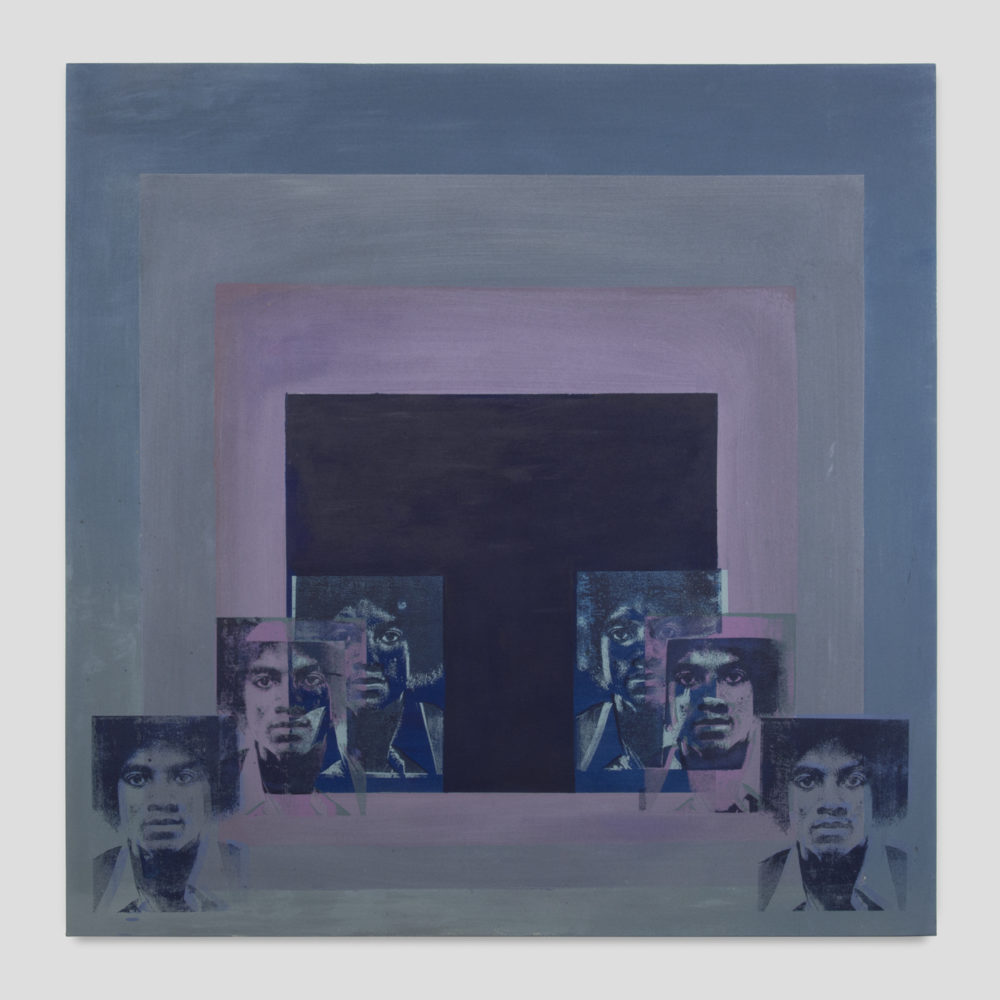
Kandis Williams’s Modernity is not merely a compromise between novel forms of commercially driven social organization and this archaic cultural pattern of patrilineal exogamy, but more fundamentally, a deepening of the compromise already integral to any exogamy that is able to remain patrilineal (2019). Courtesy of Night Gallery and David Zwirner.
RG: I haven’t used it, but I know of it.
KW: It’s interesting because it gives this fractured, dangling semiotic form, and then it’s like you can see it just hit all these different surfaces. It’s fascinating for me because I feel like it’s a dis-identification, it’s the propagandistic reordering, but it’s also this shifting—maybe towards the cliff.
RG: That’s the other thing. I want to get to a certain subjectivity, as there are many variables and possibilities of how combinations of people, of things, could or can exist, and yet, there’s still a lot that’s missing.
KW: It’s interesting, that kind of transculturation—You talk about transculturation a lot as well.
RG: A lot (laughs).
KW: There’s a theorist I love named Bracha Ettinger, who talks about trans-subjectivity and trans-subjectivization, which is again, how we, as people, go about creating the other and then creating self from the other. Tiktok just allows for these trans-subjective iterations, and it’s funny too, because it is something that happens on all Internet sites, but this is a really extreme lexical variation, rendered in a hyper niche community. And the opposite happens, where it’s like, we’ve been told so often that we have a pidgin English or Black vernacular, especially AAVE [African-American Vernacular English], and then that debated form of English is actually a stabilizing iterative. It’s the iterative. It’s like the lingua franca of the Internet, and that vernacular ends up stabilizing and reordering. It’s weird because I illustrated this Adolph Reed essay a couple of years ago called—
RG: Oh, Adolph Reed. He was someone I was involved with many years ago in an editorial project; ultimately, we didn’t produce the publication, but it’s interesting that you mention him, because the project I was working on was with Joe Wood, who sadly passed away or disappeared in 1999, as he never was found. We wanted to produce a journal around 1994, and it was called Turn; Adolph Reed was the elder we were in conversation with.
KW: I feel like Adolph Reed is also your elder, so he’s my grand-elder. But the article is called “The Trouble With Uplift.” It was published in 2017, so it was very much about public-facing, forward-facing, participatory Blackness that White institutions were really calling for. Black Is Beautiful 4.0. And that article really did not give that.
RG: I may have read that article. His writing causes reactions, negative reactions. That’s one of the reasons why we wanted to work with him.
KW: Yes, his reaction to Black Panther (2018). And one of the reasons why I was so honored to be illustrating this thing. I think conversations over dinner tables in 2020… there was a moment where “The Trouble With Uplift” was too painful. In 2016, I think we were producing new calluses, especially around language that didn’t avail us of the dissonance and discomfort that we were feeling. We were looking for Black joy, we were looking for Black unity, we were also looking for Black Is Beautiful 4.0.
It’s impossible to not see those coming together on platforms like Facebook. It’s impossible to not see the uplift as Disney+ and, thereby, cartographically seated in Hades or something (laughs). In that way I saw our generation building dissonance around participating in the structures that our generation was producing, the social structures and the structures of dissemination and structures of publication. I saw us producing a new dissonance around participating in things like…
RG: One of the things that I’ve observed lately is that there are certain gaps that happen between generations. Perhaps because those who opened things up are gone, like Joe. There are others who are quite present, and others, they’re super present (laughs); so, there’s a simultaneous combination of blinding and silencing.I like to think about durations, the long span of humans producing, those before us, and those continuing. There’s always all the stuff that seems like a problem or boring, the daily aspects of being an artist that aren’t captured in a photograph, or if it had ever been captured, it might not be the photograph that anybody would care about. It would be great to continue this conversation.
KW: Yes, because we didn’t even touch publishing…
RG: I know, but all of these things are related to publishing: what we haven’t found, what it is we’re making. Now, we both have made things, and these can be found and they can be reprinted. That’s what we were just celebrating at Bortolami Gallery recently: the reprint of Camino Road, a book that I wrote and published as part of an exhibition in 1994 for the Reina Sofía in Madrid; it was quite interesting for me to learn about your recent work dealing with what’s imagined to be a Spanish form.
KW: Can I ask you one last question?
RG: Sure, yes.
KW: Can you just maybe describe what it was like for you and your career but then, also for the positioning of Black artists politically, in terms of the global shows in ’93?
RG: Oh, the global shows of ’93. The one that would have been most known would have been the Whitney Biennial, and that was not totally global. I would say that in 1993 there weren’t too many people of African descent circulating through the art sphere. They were just like a few artists then, but many more surfaced around 1997, I would say. I think it’s important to actually understand this, as it’s just been bulldozed over, the fact that there actually wasn’t a global circulation at the time. It was mostly European. It is important to understand when things in the so-called “global” emerged in a big way. I would say that it was in 1997, with the Johannesburg Biennale and the Gwangju Biennale. There had been two previous biennales, but it was in 1997 when things really peaked in a different way. I know it from the people that I was with then, and how we were working internationally. What we’ve had mostly up until now has been a curator’s perspective, we haven’t had the artists’ perspective. We’ve had people giving props to the curators, yet the artists have a really different story. It will be interesting for that to come out further. “Inevitable Distances” is just a little start.
KW: What was the perception of cinema at the time?
RG: I can’t speak very in-depth about cinema at that particular moment, but I was writing through it. I wrote about Spike Lee in relation to things that were taking place at the moment. I wasn’t, as a person producing anything, part of cinema, but I was a very careful observer, developing a critical stance.
I was curious about how it was unfolding. It was exciting, but at the same time, as things were opening up, I had a lot of questions, including the whole gender dynamic going on; that was happening quite strongly with Julie Dash’s Daughters of the Dust (1991) and all the discussions around it.
It would be interesting to go into these things in more depth. In MIT, I have a project called Cinematic Migrations. That’s been the space in which I can examine these questions; it grew out of my wish to engage with people that I had not been in conversation with during the 1980s and in the early nineties.
It’s been very helpful to have these conversations, as I wondered, “Where are they now and how do they think about those times? What have they been able to produce for a duration of time, not just as a one-off?” As a way into these discussions, I focused on John Akomfrah and Smoking Dogs Films, formerly Black Audio Film Collective. And that’s transatlantic. I’ve been interested in a more international mixture, because in the US context, for me, it just got suffocating. That’s why I wanted a world tour. I thought, “There’s a lot here that resonates and connects in ways that we’re not usually focusing on,” and there’ve been indications through time, from the end of the 19th century, like José Martí, many writers and poets and artists. I wanted that to keep coming back, not to just disappear.
KW: Just getting to have conversations now with people that you didn’t have access to before is a real recuperation. I think there are recuperative conversations that can end certain silences between film, theater and dance.
RG: Also people of the same generation, the people who didn’t live as adults through the 1960s or the 1970s, but who were 21 in 1981. That perspective has still to come through. I guess we’re running out of time, as we are now in 2021. I have no idea what we were, but it was enjoyable (laughs).
KW: I giggled. I’ll giggle for the rest of the night (laughs).

